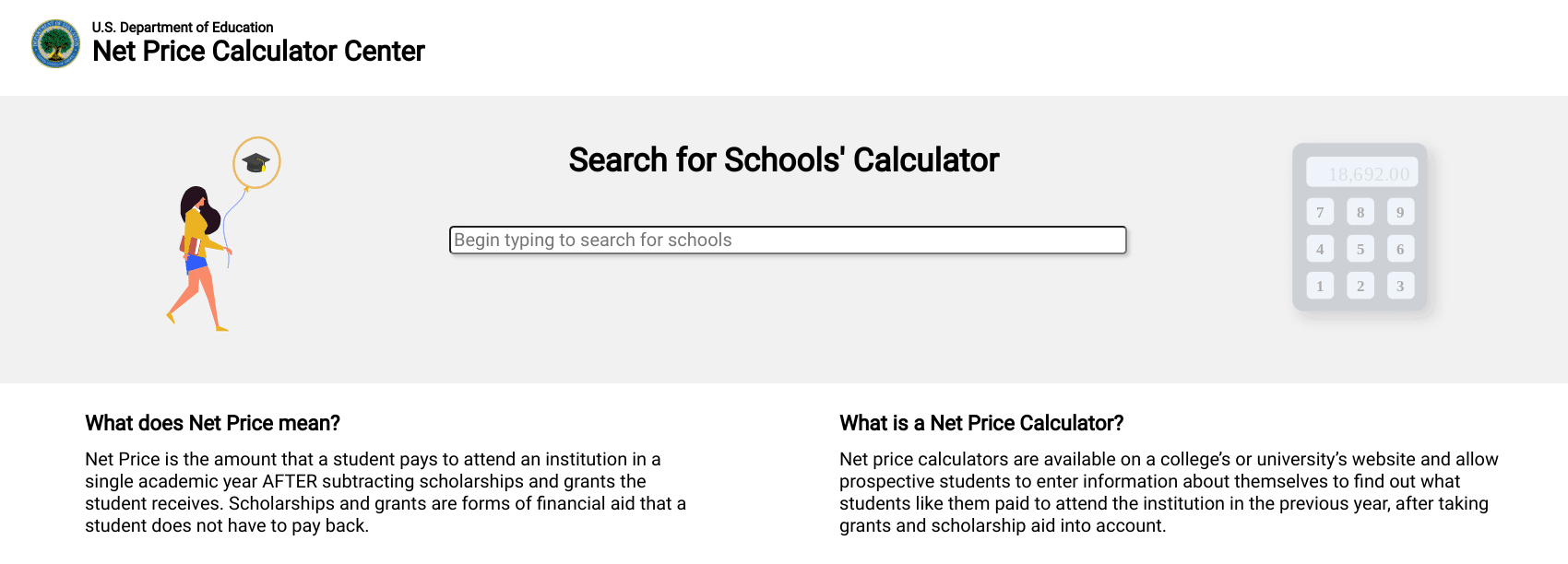
College costs are confusing, often due to a lack of clear and complete information. Understanding the true cost of college is necessary to evaluate and compare financial aid award letters.
When comparing college costs, there are three terms that enrolling students should become familiar with: cost of attendance, net price, and net cost.
In this article, we'll define each of these terms mean and lay out their differences. We'll also explain why the estimated costs that colleges report can be misleading. Here's what you need to know.
What Is The Cost Of Attendance (COA)?
Everything starts with the cost of attendance, which is the total annual college costs, not just tuition and fees. The cost of attendance is also known as the sticker price.
The cost of attendance includes tuition and fees as well as allowances for room and board, books, supplies and equipment, transportation, the cost of a personal computer and miscellaneous personal expenses.
In addition, there are optional allowances that are available upon request. These include allowances for dependent-care costs, disability-related expenses, study abroad costs, cooperative education expenses, loan fees, and the cost of professional licensing or certification.
Some college financial aid award letters do not list the full cost of attendance. Instead, they distinguish between direct costs, which are paid to the college, and indirect costs. Students and parents may need to search the college’s website to find information about indirect costs.
What Is The Net Price?
The net price subtracts gift aid, such as grants and scholarships, from the sticker price. It's effectively a discounted sticker price.
Only gift aid from the federal government, state government, and the college itself is subtracted. Scholarships from private sources isn’t subtracted from the cost of attendance in the definition of net price.
The net price is the amount of money the family will have to pay from savings, income and loans, as well as education tax benefits and private scholarships, to cover college costs.
Since 2011, every college has been required to provide a net price calculator on its website. The net price calculator provides a personalized estimate of the student’s net price at the college. Net price calculators are useful tools for estimating the one-year net price before the student applies for admissions and financial aid.

What Is The Net Cost?
Some colleges promote a net cost figure instead of, or in addition to, the net price. It's important to not confuse the two.
Net cost subtracts the entire financial aid package, including student loans, from the cost of attendance. The net cost is usually lower than the net price, which subtracts just grants and scholarships. In addition to including student loans in the financial aid package, some schools also include parent loans, which is called “packaging PLUS."
"Promoting a net cost figure can be misleading..."
But loans do not really cut college costs. They must be repaid, usually with interest. For this reason, promoting a net cost figure can be misleading, especially when financial aid award letters do not clearly distinguish loans from grants.
Why Estimated College Costs Can Be Deceiving
The cost of attendance and net price provide cost information for just one year, the freshman year.
But costs in subsequent years are often higher.
More than half of colleges practice front-loading of grants, where there is a better mix of grants vs. loans during the first year than during the sophomore, junior and senior years in college. Other colleges don't cut grants in subsequent years, but the net price nevertheless increases because of inflation in tuition, fees and other college costs.
Families can use the U.S. Department of Education’s College Navigator tool to determine whether a college practices front-loading of grants and to estimate an adjustment to the net price for all four years. Here's how to do it:
- Expand the financial aid tab for the college of interest. There will be two sets of financial aid information, one for full-time beginning undergraduate students (i.e., first-year students) and one for all undergraduate students.
- Examine the “Grant or scholarship aid” rows. These provide information about the percentage of students receiving gift aid, as well as the average aid amount. If either of these numbers decrease, it can be a sign that the college practices front-loading of grants.
Note: The numbers in the "grant or scholarship aid" rows can also decrease if the college has many transfer students and is less generous to transfer them or if the college has a very low retention rate for Federal Pell Grant recipients. These are not significant factors at most colleges, however.
Related: What Is The Average Cost Of College?
How To Adjust Your College Cost Estimates
To calculate an adjustment to the net price requires evaluating how the gift aid and college costs will change. Here's how to do that.
Calculating Your Adjusted Cost Of Attendance
- Look for the percentage in the rightmost column under the “Tuition, Fees and Estimated Student Expenses” tab in College Navigator.
- Pick the appropriate line under the Total Expenses section of the tab.
- Multiply this percentage by 1.5 and add it to 100%. Multiply the result by the total cost of attendance from the financial aid award letter or the college’s website. This is the adjusted cost of attendance amount.
Calculating Your Adjusted Gift Aid
- Calculate the ratio of average gift aid for all undergraduate students to the average gift aid for first-year students.
- If there is a significant difference in the percentage receiving grants, multiply this ratio by the ratio of the percentages. The resulting ratio will be less than 100%.
- Multiply this ratio by the total gift aid in the financial aid award letter. This is the adjusted gift aid amount.
Calculating Your Adjusted Net Price
To calculate the adjusted estimate net price for the entire undergraduate program, subtract the adjusted gift aid amount from the adjusted cost of attendance amount. Suppose that a college has the following details:
- Cost of attendance: $35,000
- Average gift aid of first-year students: $15,000
- Average gift aid of all undergraduate students: $10,000
- College cost inflation rate: 3%
First of all, it's clear right off the bat (from the difference in average gift aid for first-year students and all undergrads) that this college clearly practices front-loading of grants. And we also see that the school's tuition and fees have been increasing by 3% each academic year.
So let's say that you receive a financial aid award letter from this school that lists a total of $12,000, yielding a net price of $23,000. Here's how you would use the steps explained in the previous section to adjust your gift aid amount, cost of attendance, and net price.
$35,000 x (100% + 1.5 x 3%) = $36,575 adjusted cost of attendance
$12,000 x $10,000 / $15,000 = $8,000 adjusted gift aid
$36,575 - $8,000 = $28,575 adjusted estimated net price
That last number ($28,575) is much higher than the net price based on the first-year financial aid award letter of $23,000. This example shows why it's so important to calculate how your gift aid and college costs will change over the course of your academic career.
The Problem Of Scholarship Displacement
Many colleges require students to report private scholarships to the college’s financial aid office. Some of these colleges practice scholarship displacement, where the college’s own grants are reduced when the student receives a private scholarship.
"If private scholarships are fully displaced, there is no change in the student’s ability to pay for college."
According to a recent study of college students, half of scholarship recipients are affected by scholarship displacement. If a student’s private scholarships are fully displaced, there is no change in the net price or the student’s ability to pay for college, despite their hard work in winning a scholarship.
Therefore, it's important to understand whether and how a college practices scholarship displacement. Some colleges publish an “outside scholarship policy” on their website. Sometimes, this policy is specific enough to evaluate how winning a private scholarship will affect the net price. You can also ask questions to a college financial aid administrator, such as, “If I win a $10,000 scholarship, how will that affect my financial aid package?”
Two states – Maryland and New Jersey – have enacted laws banning scholarship displacement. An, if passed, The Helping Students Plan for College Act of 2021 (H.R. 5380) would require colleges to disclose their scholarship displacement policies to prospective and enrolled students.
Final Thoughts
With various numbers to consider, calculating college costs can seem overwhelming. But with a little digging and some basic math, you can quickly gain a clearer picture of what you'll actually be paying overall to earn a degree at any specific school.
And once you have a firmer gauge of your college's costs, you'll want to carefully think through how you'll cover them. For tips and ideas on that front, check out our guide: How To Pay For College.

Mark Kantrowitz is an expert on student financial aid, scholarships, 529 plans, and student loans. He has been quoted in more than 10,000 newspaper and magazine articles about college admissions and financial aid. Mark has written for the New York Times, Wall Street Journal, Washington Post, Reuters, USA Today, MarketWatch, Money Magazine, Forbes, Newsweek, and Time. You can find his work on Student Aid Policy here.
Mark is the author of five bestselling books about scholarships and financial aid and holds seven patents. Mark serves on the editorial board of the Journal of Student Financial Aid, the editorial advisory board of Bottom Line/Personal, and is a member of the board of trustees of the Center for Excellence in Education. He previously served as a member of the board of directors of the National Scholarship Providers Association. Mark has two Bachelor’s degrees in mathematics and philosophy from the Massachusetts Institute of Technology (MIT) and a Master’s degree in computer science from Carnegie Mellon University (CMU).
Editor: Robert Farrington Reviewed by: Chris Muller
